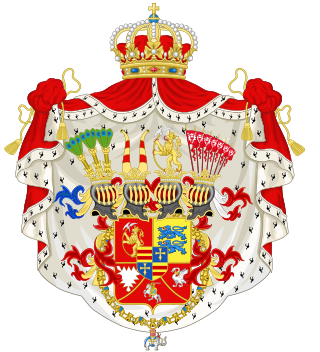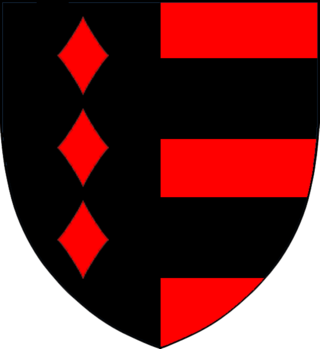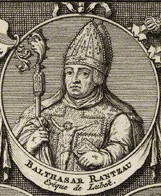

The Reventlow family is a Holstein and Mecklenburg Dano-German noble family, which belongs to the Equites Originarii Schleswig-Holstein. [1] Alternate spellings include Revetlo, Reventlo, Reventlau, Reventlou, Reventlow, Refendtlof and Reffentloff.


The Reventlow family is a Holstein and Mecklenburg Dano-German noble family, which belongs to the Equites Originarii Schleswig-Holstein. [1] Alternate spellings include Revetlo, Reventlo, Reventlau, Reventlou, Reventlow, Refendtlof and Reffentloff.
In 1223, Godescalcus de Revetlo of Holstein was first mentioned in writing. He was vassal of Count Albrecht of Orlamünde and Holstein. In 1236 and 1258, Thitlevus de Revetlow was in Mecklenburg in the wake of the Prince Johann I. In both countries, members of the family were able to gain significant professional and economic positions over time.
The old Holstein line, also found from the 14th to the 16th century in Funen, ended in 1752. With the extinction of the Gallentiner branch in 1772, the Mecklenburg branch also ended. Relatives from this branch, however, had previously settled in the Duchy of Schleswig. From Ziesendorf (in Mecklenburg) came Detlef Reventlow, who was appointed chancellor of Christian IV of Denmark in 1632. He was progenitor of two new branches, both of which came to great influence.
The older branch acquired the Danish lord-dignity in 1767.

The younger branch had acquired by 1673 the Danish Graf and on July 23, 1706, to Vienna the Count of the Holy Roman Empire. Conrad von Reventlow (1644–1708), Grand Chancellor and Prime Minister of Christian V of Denmark, received the higher feudal rank and was awarded the Liege County of Reventlou - Sandbjerg in Schleswig. His son acquired the feudal county Christianssæde on Lolland and the feudal barony Brahetrolleborg on Funen.
The younger daughter of Conrad von Reventlow, Anna Sophie von Reventlow (1693–1743), became in 1712 consort of King Frederick IV of Denmark and Duchess of Schleswig. In 1721 she was crowned Queen of Denmark. Other Reventlows were related by marriage to the Dukes of Holstein. The Reventlow family counts important personalities of the European aristocracy, including the last German empress Auguste Victoria.
Detlev von Reventlow (1712–1783), heir of the Altenhof and Glasau estates, bought Gut Emkendorf in 1764, from Detlef von Reventlow Gut Wittenberg in 1767, and the Altenhof neighboring Gut Aschau in 1782.
The Counts of Reventlow-Criminil with a Danish diploma of 1815 belonged in the male line to the French Marquis Le Merchier de Criminil. Joseph and Heinrich were the sons of a niece of Julia von Reventlow who she and her husband Friedrich Karl Reventlow adopted. Joseph inherited the Emkendorf in 1828; his descendants sold it in 1929.
In addition to the Schleswig-Holstein and Mecklenburgian possession, estates which were temporarily in the possession of the Reventlow included Good Bülk (around 1350), Gut Kaden (15th century), Gut Waterneverstorf (1592–1662), Gut Dobersdorf (in the 17th century, from 1625), Gut Altenhof (1691–1960, inherited from the family of Bethmann-Hollweg) with Wittenberg and Gut Jersbek (1840–1960), Quarnbek and Schmoel (around 1700), Hohenfelde with Kollmar (around 1700–1739), Gut Rantzau (1728–1740), Gut Emkendorf (1764–1929), Gut Kaltenhof ( 1780–1910), Gut Falkenberg (1790–1848), Gut Testorf (18th century), and Gut Farve (19th century to 1926).
In Schleswig-Holstein the family is still based in Gut Damp (since the end of the 16th century), Gut Wittenberg (since 1584), Gut Wulfshagen (at Tüttendorf, since 1903) and Gut Eckhof (since 1972).
In Denmark, Gram Castle was taken over or built by the Reventlow around 1470 and remained in the family until 1664. In 1673, Prime Minister Conrad Reventlow acquired the Sandbjerg Castle (1673–1930 owned by the family) with Gut Ballegård and built Clausholm Castle (owned 1690–1743). His son Christian Detlev of Reventlow acquired Brahetrolleborg on Funen (1722–1960), Pederstrup on Lolland (1725–1935) and Christianssæde on Laaland (1728–1934). His son Conrad Detlev Reventlow (1704–1750) married Wilhelmine Auguste, the sister of the Duke Friedrich Karl of Schleswig-Holstein-Sonderburg-Plön in 1731. In 1739 he acquired the Krenkerup Castle at Radsted Sogn with Nørregård and Rosenlund (1739–1793). In 1900, the estate Agerupgård in Våbensted Sogn came to the Counts Reventlow, who are still there.
Commoner descendants in the female line with the name Reventlow (no title of nobility) are the families Reventlow-Mourier on Brahetrolleborg and Reventlow Grinling on Krenkerup, as well as some descendants in the cognitive line in Sweden.
The family crest of the family is divided in the Zinnenschnitt of silver over red. On the helmet with red-silver blankets stands a gold ring (feather play) set all around with silver feathers on a short red pole.
Elements and colours from the coat of arms of the family Reventlow appear today in some Schleswig-Holstein municipal coat of arms. [2]



Frederick VIII, Duke of Schleswig-Holstein and of Schleswig-Holstein-Sonderburg-Augustenburg was the German pretender to the throne of second duke of Schleswig-Holstein from 1863, although in reality Prussia took overlordship and real administrative power.

The House of Schleswig-Holstein-Sonderburg-Glücksburg, better known as the House of Glücksburg, is a collateral branch of the German House of Oldenburg. Its members have reigned at various times in Denmark, Norway, Sweden, Iceland, Greece, and several northern German states.

The House of Oldenburg is an ancient dynasty of German origin whose members rule or have ruled in Denmark, Iceland, Greece, Norway, Russia, Sweden, the United Kingdom, Livonia, Schleswig, Holstein, and Oldenburg. The current King of the UK and King of Norway are agnatic members of this house, meanwhile the King of Spain and King of Denmark are matrilineal members.

Frederick Christian II, Duke of Schleswig-Holstein-Sonderburg-Augustenburg was a Danish prince and feudal magnate. He held the island of Als and some other castles in Schleswig.

The House of Ahlefeldt is an ancient German and Danish noble family. It has similar coat of arms with the von Rumohr family, which indicates that they have descended from one House.

Countess Friederike Charlotte Antoinette of Dohna-Schlodien in Leistenau was a German noble woman.

The Thienen family is the name of an ancient noble family, that origins in the Duchy of Holstein. The spelling of the name, over the centuries has changed from Tyne and Tynen to Thien, Tienen, Thinen and finally Thienen. The barons of Thienen-Adlerflycht are the only branch of this family still existing; they belong to the high nobility of Denmark.

Christian Detlev, Count von Reventlow (1671–1738) was a Danish military leader and diplomat.

The Duchy of Holstein was the northernmost state of the Holy Roman Empire, located in the present German state of Schleswig-Holstein. It originated when King Christian I of Denmark had his County of Holstein-Rendsburg elevated to a duchy by Emperor Frederick III in 1474. Members of the Danish House of Oldenburg ruled Holstein – jointly with the Duchy of Schleswig – for its entire existence.

Conrad, Count von Reventlow was a Danish statesman who was "Grand Chancellor of Denmark", a predecessor title of the Prime Minister of Denmark, from 1699 until his death. His chancellorship occurred during the reign of King Frederick IV.

Frederick Charles of Schleswig-Holstein-Sonderburg-Plön, known as Friedrich Karl or Friedrik Carl of Holstein-Plön, was a member of a cadet branch of the Danish royal family and the last duke of the Duchy of Schleswig-Holstein-Sonderburg-Plön, a Danish royal prince, and a knight of the Order of the Elephant. When he died without a male heir born of his marriage to Countess Christine Armgard von Reventlow, rule of the Duchy of Holstein-Plön returned to the Danish crown.

The House Order of Albert the Bear was founded in 1836 as a joint House Order by three dukes of Anhalt from separate branches of the family: Henry, Duke of Anhalt-Köthen, Leopold IV, Duke of Anhalt-Dessau, and Alexander Karl, Duke of Anhalt-Bernburg.
Duke Christian Charles of Schleswig-Holstein-Sonderburg-Plön-Norburg was an officer in the Brandenburg-Prussian army.

Dorothea Christina von Aichelberg was the spouse of Prince Christian Charles of Schleswig-Holstein-Sonderburg-Plön-Norburg as Frau von Karlstein. Later, as a widow and mother of Frederick Charles, she stood for many years at the center of a succession dispute.

Sandbjerg is a former estate and manor house 5 km (3.1 mi) north of Sønderborg in the southeast of Jutland, Denmark. The estate dates from 1571, but today's house was built in 1788. Since 1959, the estate has been used by Aarhus University for teaching and research. Today it is the university's conference centre.

Christianssæde is a manor house and estate located close to Maribo on the island of Lolland in southeastern Denmark.

Louise Albertine, Princess of Anhalt-Bernburg was a member of the Danish royal family and the consort of Frederick Albert, Prince of Anhalt-Bernburg.

Lucie Marie Ludovika Anastasia Adelheid Karola Hedwig Reventlow (1884–1984) was a German-born Danish philanthropist who is remembered for supporting the scout movement in Denmark. In particular, she adapted her home, Brahetrolleborg Manor on the island of Funen, as a scouting school. In addition, she created a housekeeping school on the premises. After spending the Second World War in England, where she served in the Air Raid Precautions, she returned to Brahetrolleborg, upholding its historical traditions until she died, almost 100 years old.

Balthasar Rantzau was a Prince-Bishop of the Diocese of Lübeck. He became known for his tragic end as a kidnapping victim.